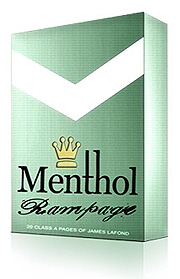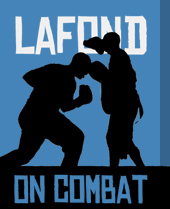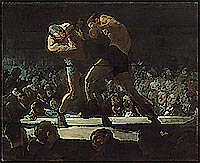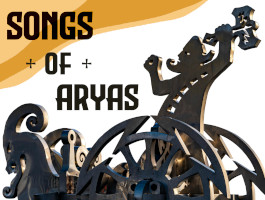Boxing is not a monolithic art buts a synthesis of traditions. What follows is some notes on the various schools of boxing, as expressed in the guard adopted by the fighter. Many fighters have only one guard. Some fighters like George Foreman or Marvin Hagler adapted a different guard as an older fighter than they did as a young fighter. Other fighters might slide across a variety of guards as the guards and abilities of their opponents vary. If you are a non-combat sports fan a guard is the fighter’s posture. If you are a martial artist you probably refer to it as a stance.
Classic Guard
This is an oblique posture with the rear foot flexed. The elbows rest on the ribs. The lead hand is a hand-span in front to the lead shoulder. The rear hand is a hand span before the rear shoulder and up to a hand-span away from the chin. With normal-length arms a fighter’s fists will reach his jaw-line and his open fingers will reach his cheeks. The right shoulder and hip are not squared toward the opponent but reserved for pivot-leverage. The boxer looks through his hands, not over them.
This is considered optimal and is taught by most coaches. This style traces its origin through Joe Louis to Blackburn and the Detroit boxing tradition.
The Open Guard
This is the same as the Classic but with the rear shoulder and hip squared. This posture tends to draw the rear foot forward some once the action begins and may lead to an almost lateral foot position. It tends to weaken your straight punch options and open up your center line. This guard is favored by aggressive pressure-fighters who prefer to hook with the rear hand. Boxers who have exceptional lateral movement and head movement can make this work if they are well-conditioned.
The Closed Guard
This is the same as the Classic but is more lineal with the lead foot between the opponent and the rear foot. This is a defensive orientation favored by fighters who rely on lead-hand strikes as it retards rear-hand punching leverage. This is favored by karate point-fighters, and was used by old-time boxers as they evolved the bare-knuckle guard to gloves. The rear foot is sometimes pointed out at a right angle. Modern boxers usually only employ this guard when injured.
Low Guard
This is the ‘Ali’ or ‘hot-shot’ boxing stance. It the same as the Classic with the lead hand held low. It is favored by tall fast boxers who like to use an up-jab to lift the chin. This is frowned upon as a ‘show-boating’ style. However, some older boxers go to a low lead while bringing the rear hand forward to guard the chin, as a way of drawing a faster opponent in for counter-punching opportunities. This later application is a step towards a true Peek-a-boo Guard. The taller young fighter that uses this will tend to be on his toes and lead. The older shorter fighter who uses this will tend to be partially flat-footed and counter.
Peek-a-boo Guard
This is an extreme form of the Low Guard, with both hands held low, and often crossed. It has traditionally been favored by smaller and older heavyweights. The boxer fights from a crouch and depends on head-movement and shoulder shrugging to protect the head. Archie Moore, Joe Frazier, and later George Foreman used this guard successfully. It is generally held in disrepute in this day of super-heavyweights. Smaller heavyweights now rely on a more Classic Guard supplemented by a High Guard. This guard is usually used flat-footed.
High Guard
This is an Open Guard with the elbows held out from the body and the boxer looking through his forearms rather than through his hands. This guard was used in ancient times when it was called ‘high-handedness’, and in bare-knuckle boxing when it was employed by movers [fighters who move around more than their opponents]. It is still used to walk a man down or to rest on the ropes as in Ali’s famous ‘rope-a-dope’. In modern boxing nobody uses it all the time. It is more-or-less a tactical option employed when necessary, usually by weary or stumped fighters. The High Guard is usually flat-footed. The hand positioning is similar to Muay Thai except the loose fists are held palm-in instead of palm out.
Bare-knuckle Guard
This is a closed guard with the lead held low and the fist extended palm up. The rear hand forearm is held across the solar-plexus with the fist resting below the heart palm up. This was the standard guard for bare-knuckle and small glove fighters and shows up in some ancient bare-knuckle examples. The purpose is to protect the body and thumbs. It is not practical when the fighters are armed with hand-gear that permits the skull to be safely punched. Like the Peek-a-boo and High Guard this guard is generally flat-footed.











